Mahatma Gandhi & The Nationalist Movement Class 12 History
| Table of contents |

|
| Introduction |

|
| A Leader Announces Himself |

|
| The Making and Unmaking of Non-cooperation |

|
| The Salt Satyagraha: A Case Study |

|
| Quit India |

|
| The Last Heroic Days |

|
| Knowing Gandhi |

|
| Conclusion |

|
Introduction
Mahatma Gandhi, known as the 'Father of the Nation,' played a crucial role in India's fight for freedom. His methods of non-violent protest and civil disobedience inspired millions and reshaped the nationalist movement in India. This chapter explores Gandhi's activities from 1915 to 1948, his interactions with different sections of society, and the popular struggles he led.
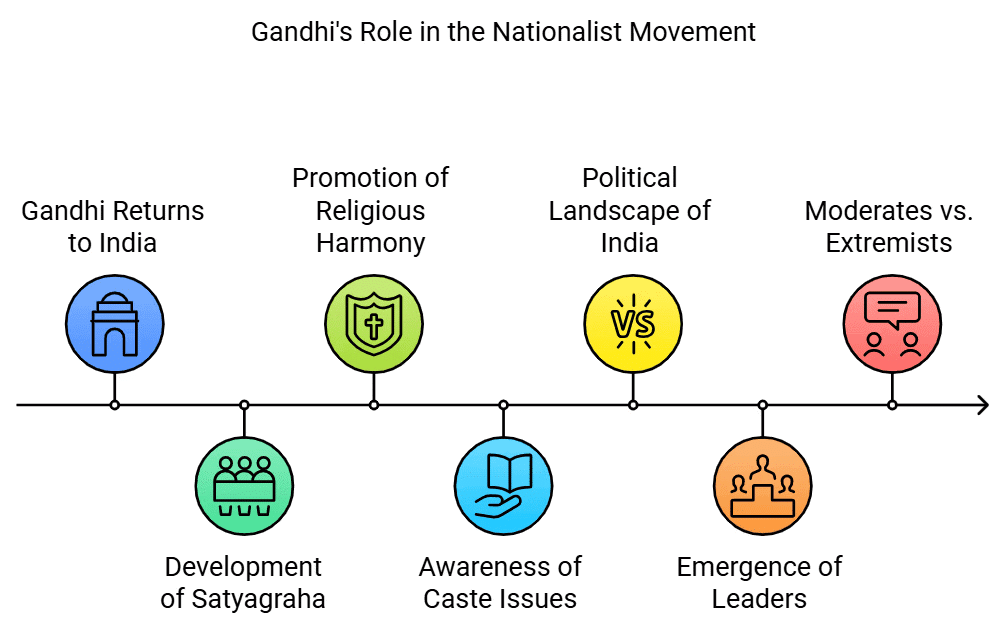
A Leader Announces Himself
Return to India (1915)- Gandhi came back to India in January 1915 after spending about twenty years in South Africa, where he went as a lawyer and became a leader for the Indian community. During this time, he developed his method of non-violent protest called satyagraha.
- In South Africa, Mahatma Gandhi pioneered the unique techniques of non-violent protest known as satyagraha, promoted harmony among different religions, and raised awareness among upper-caste Indians about their unfair treatment of low castes and women.

Political Landscape of India
- In 1915, India was politically active with the Indian National Congress having branches in major cities and towns.
- Leaders like Bal Gangadhar Tilak, Bipin Chandra Pal, and Lala Lajpat Rai ("Lal, Bal, and Pal") had broadened the appeal of nationalism. These leaders supported military opposition against colonial rule.
- Moderates: unlike the other leaders, the moderates favored a slower and more convincing method, including Gandhi's political mentor, Gopal Krishna Gokhale and Mohammad Ali Jinnah.
First Major Public Appearance
At the BHU event, compared to the other dignitaries, Gandhiji was relatively unknown. His invitation was based on his work in South Africa, rather than his prominence in India.
Key Insight
- Gandhi's speech highlighted that Indian nationalism was mainly an elite movement, created by lawyers, doctors, and landlords.
- It also expressed his intention to make nationalism more inclusive of the entire Indian population.
- He reminded the audience of the peasants and workers who made up the majority but were missing from the gathering.
Gandhi voiced his concern about the difference between the wealthy noblemen present and the many poor Indians who were not there. He stated, "there is no salvation for India unless you strip yourself of this jewellery and hold it in trust for your countrymen in India." He emphasized that "Our salvation can only come through the farmer. Neither the lawyers, nor the doctors, nor the rich landlords are going to secure it."
At the BHU event, many were surprised by Gandhi’s boldness as he was relatively unknown in India compared to his work in South Africa.
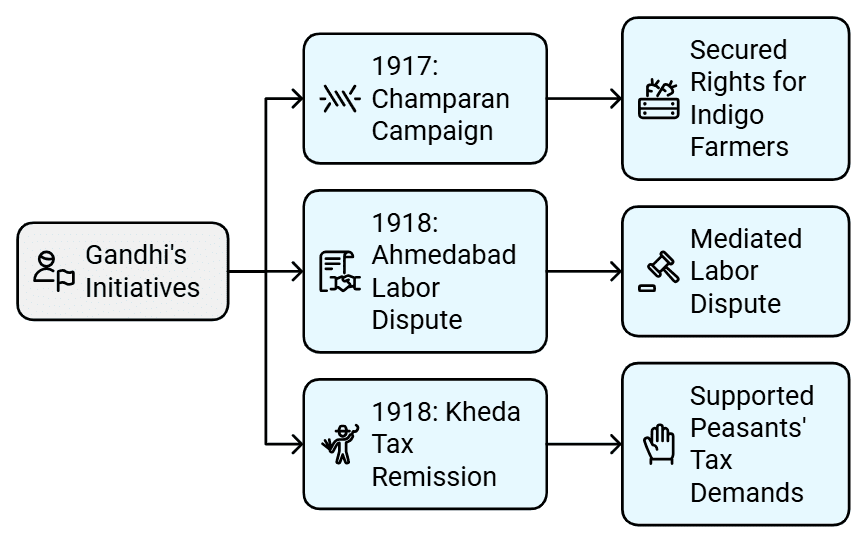
The Making and Unmaking of Non-cooperation
Early Initiatives- In 1917, Gandhi led a successful campaign in Champaran, Bihar, securing rights for indigo farmers against British planters.
- In 1918, he mediated a labor dispute in Ahmedabad and supported peasants in Kheda demanding tax remission due to crop failure.
Rowlatt Act and Jallianwala Bagh Massacre
- Gandhi called for a countrywide protest against the Rowlatt Act of 1919, leading to widespread unrest. In towns throughout North and West India, life stopped as shops closed, and schools shut down due to the bandh call.
- The Jallianwala Bagh massacre, where British troops killed hundreds of unarmed protesters, intensified nationalistic fervor.
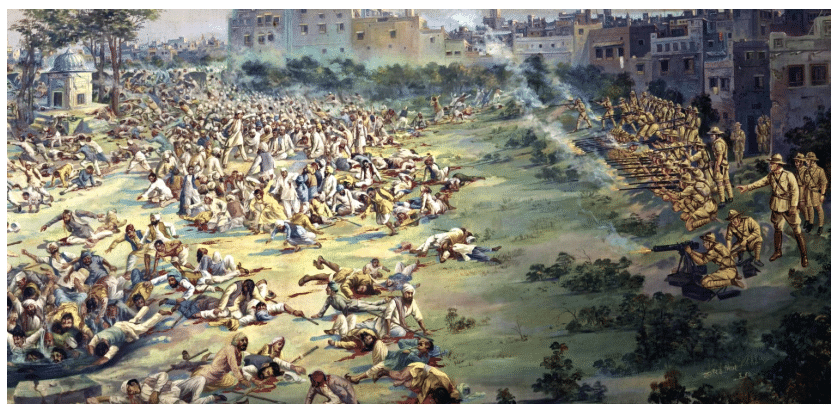
Non-cooperation Movement (1920-1922)
- Gandhi launched the Non-cooperation Movement, encouraging Indians to boycott British institutions and goods. The movement saw a large number of participants, including strikes and acts of civil disobedience throughout India.
- Students stopped attending government schools, and lawyers refrained from going to court. The working class staged strikes in many areas: official records showed 396 strikes in 1921, involving 600,000 workers and resulting in a loss of seven million workdays. The countryside was also filled with discontent.
- Gandhi stressed that non-cooperation involved denial, renunciation, and self-discipline, which he viewed as training for self-rule. He believed that if non-cooperation was effectively pursued, India would achieve swaraj within a year.

Knitting a Popular Movement
- Gandhi joined forces with the Khilafat Movement, which aimed to restore the Caliphate in Turkey.
- Gandhi's aim was to combine non-cooperation with the Khilafat movement so that India’s two major religious communities, Hindus and Muslims, could work together to end colonial rule.
- Both the movements gained massive support, with students, lawyers, workers, and peasants participating in large numbers.
- Non-cooperation was designed to be peacefully impactful: it involved refusal, giving up certain things, and practicing self-discipline.
- As a result, the foundations of the British Raj were shaken for the first time since the 1857 Revolt.
Chauri Chaura Incident
- In February 1922, violence erupted in Chauri Chaura, in the United Provinces (now, Uttar Pradesh and Uttaranchal), where a group of peasants attached a police station
- This led to Gandhi calling off the Non-cooperation Movement.
- He emphasized non-violence and suspended the movement to prevent further bloodshed.
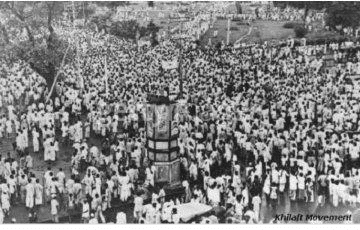
The Non-cooperation Movement saw students leaving schools and colleges, and lawyers giving up their practices to support the cause.
Challenges and Conclusion
- The Non-cooperation Movement was called off in 1922 after the violent incident at Chauri Chaura.
- Gandhi was arrested and sentenced to six years in prison but was released in 1924.
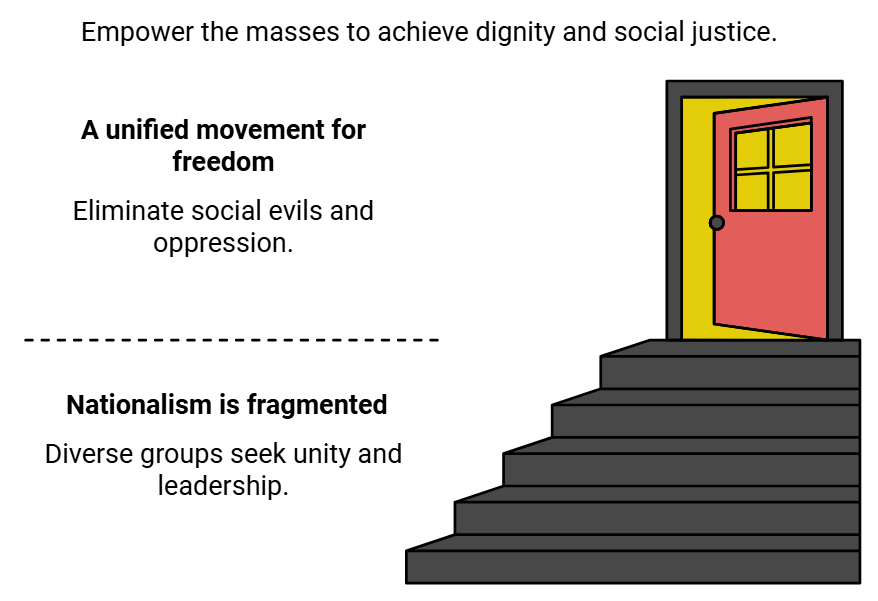
A People's Leader
- Gandhi transformed Indian nationalism into a mass movement, involving peasants, workers, and artisans from his BHU speech in 1916 to the conclusion of the non-cooperation movement in 1922.
- Many had started referring to Gandhi as their "Mahatma".
- Gandhi seemed to the Indian peasants like a savior who would free them from heavy taxes and harsh officials and restore their dignity and control over their lives.
- His simple lifestyle, symbolized by the dhoti and charkha, resonated with the common people.
- Gaining popularity among the wealthy: Among the rich Indian businessmen and industrialists, some had openly started supporting Gandhi while others did it tactfully while hiding from the British authorities.
- After his release from imprisonment in 1924, Gandhi diverted his attention to the promotion of Indian-made cloth khadi and the abolition of untouchability.
- Getting rid of social evils: Gandhi believed that to enjoy freedom, Indians needed to eliminate social issues like child marriage and untouchability.
The mass nationalism movement that Gandhi started is also referred to as Gandhian nationalism.
Key Insight
Gandhi's non-cooperation campaign broadened the base of Indian nationalism, engaging peasants, workers, and other marginalized groups in the struggle for independence.
The Salt Satyagraha: A Case Study
Context and Strategy
- After his release from prison, Gandhi had focused solely on social reform work. By 1928, however, he started considering re-joining politics.
- Annual session of Congress in 1929: Jawaharlal Nehru was elected as President and the proclamation of commitment to “Purna Swaraj” was made
- On January 26, 1930, "Independence Day" was celebrated with the national flag raised at various locations and patriotic songs sung. Gandhiji provided detailed instructions on how the day should be observed.
- Soon after that day, Gandhi initiated the Salt Satyagraha to protest the British monopoly on salt production and sales.
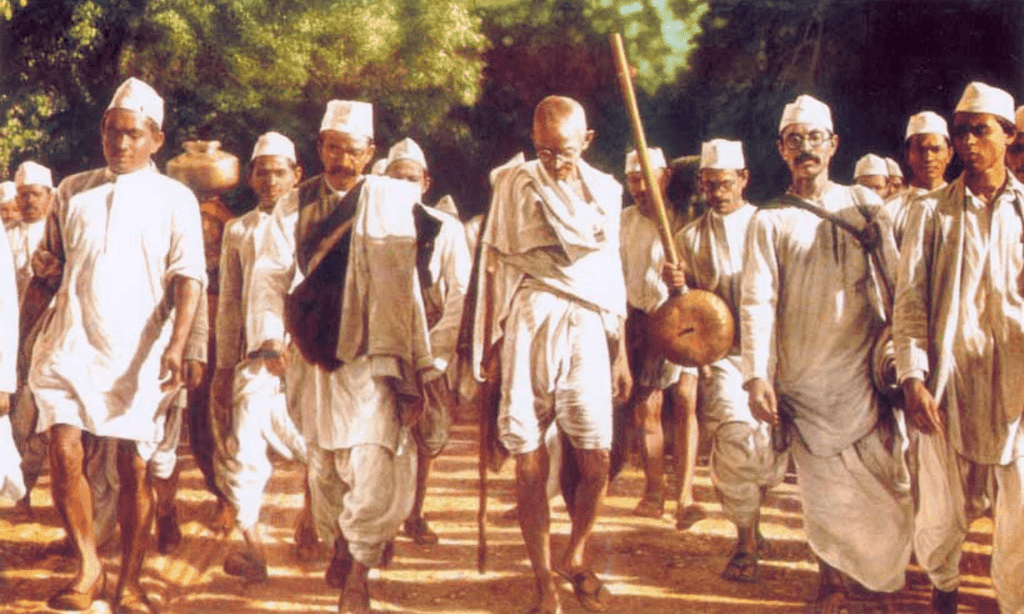
Impact and Response
- The Dandi March, also known as the Salt March, began on March 12, 1930, and ended on April 6, 1930, with Gandhi making salt at Dandi. At the same time, similar salt marches were taking place in other parts of the country.
- The march to Dandi was a symbolic act to challenge British authority, as salt was a basic necessity for all Indians.
- The Salt March drew massive support and international attention, highlighting the unjust policies of the British Raj.
- The British response was severe, with mass arrests, including Gandhi himself.
Why the Salt Satyagraha?
- Salt was crucial, and the British monopoly on its production was widely hated. By focusing on the salt tax, Gandhi brought together people from various regions and social backgrounds, making it a central issue against British rule.
- This was significant as it marked the first major nationalist movement with considerable female participation, further expanding the movement's reach.
Progress of the March
- Gandhi's march from Sabarmati to Dandi attracted widespread attention.
- The police reports and international media coverage documented the growing support for the movement.
- There are reports of Gandhi being unwell but still gathering strength to march further, as well as documentation of his powerful speeches along the way.
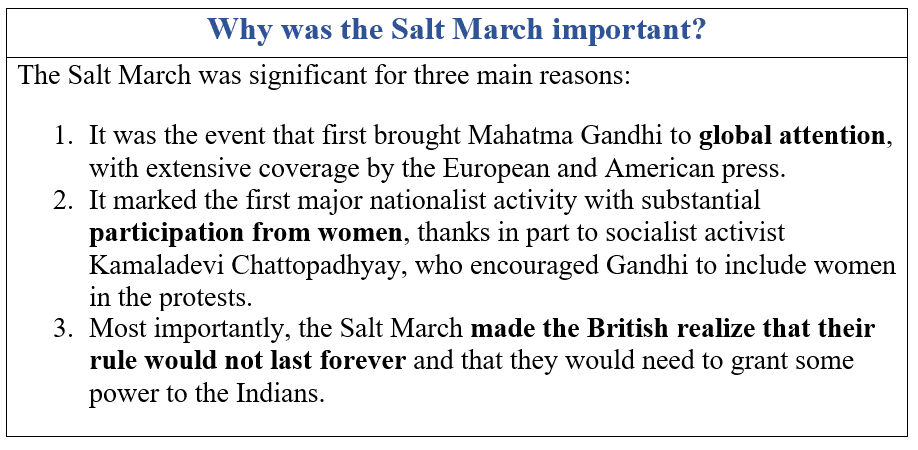 Importance of Salt (Dandi) March
Importance of Salt (Dandi) March
Gandhi and his followers walked 240 miles during the Dandi March, gathering supporters and attention along the way.
Dialogues
- The Gandhi-Irwin Pact was signed in 1931, which led to stopping the civil disobedience movement and the release of political prisoners. One of its terms allowed for salt production along the coast.
- The first Round Table Conference took place in November 1930, but it was ineffective as the main political leader in India was absent. Gandhi attended the Second Round Table Conference in London in 1931, but since it did not achieve any results, he returned to India and resumed civil disobedience.
- In 1935, a new Government of India Act was established, leading to Congress “Prime Ministers” in eight out of 11 provinces, under the direction of a British Governor. When talks with the Viceroy failed in October 1939, the Congress ministries resigned.
- In 1940, the Muslim League called for autonomy for regions with a Muslim majority, highlighting the increasing political divide in India.
Quit India
Background
- Following the failure of the Cripps Mission in 1942, Gandhi launched the Quit India Movement, calling for an end to British rule.
- The movement was marked by widespread protests, strikes, and acts of sabotage.

Government Response and Outcome
- The British responded with repression, arresting thousands of activists, including Gandhi and other Congress leaders.
- Despite the crackdown, the Quit India Movement significantly intensified the demand for independence, setting the stage for India's eventual freedom.
Independent Governments
- In districts like Satara and Medinipur, parallel governments were established by local leaders, showcasing the widespread support for the movement.
Rise of the Muslim League
- While Congress leaders were in jail, Jinnah and his Muslim League colleagues were carefully working to broaden their influence.
- On being released from jail in 1944, Gandhi conducted several meetings with Jinnah in an effort to bridge the divide between the Congress and the League.
- However, in the 1946 election results for provinces, the divide between the religions was clear.
- Direct Action Day: Jinnah called for a "Direct Action Day" on 16 August 1946 to push for the League’s demand for Pakistan. As a result, violent riots erupted in many parts of the country. Both Hindus and Muslims suffered.
Division Announced
- Mountbatten, on coming into power in February 1947, called for one final round of talks, but when these also failed to produce results, he announced that British India would be both freed and divided.
- The formal transfer of power was set for August 15.
The slogan "Do or Die" became popular during the Quit India Movement, inspiring many to join the struggle.
The Last Heroic Days
Efforts for Communal Harmony
- Gandhi worked hard to bring peace between Hindus and Muslims during the partition of India. He went on a fast to promote reconciliation and protect minorities.
- At the suggestion of Gandhi and Nehru, the Congress passed a resolution regarding the rights of minorities.
- In September and October, as noted by his biographer D.G. Tendulkar, Gandhi visited hospitals and refugee camps to comfort distressed individuals.
- He urged Sikhs, Hindus, and Muslims to let go of their past grievances and to unite in a spirit of fellowship and peace.

Assassination and Legacy
- Gandhi was assassinated on January 30, 1948, by Nathuram Godse.
- His death was mourned globally, and his principles of non-violence and social justice continued to inspire movements worldwide.
Gandhi's last words were "Hey Ram," which reflected his deep spiritual beliefs.
Knowing Gandhi
Public Voice and Private Scripts
- Gandhi's writings and speeches provide insights into his public and private thoughts.
- His letters reveal his interactions with associates and adversaries, reflecting his ideals and strategies.
Framing a Picture
- Gandhi's autobiography, "The Story of My Experiments with Truth," offers a personal account of his life and principles.
- Autobiographies offer a personal view of historical events, shaped by the author's perspective and memory.
- Gandhi's autobiography and the writings of his contemporaries help frame a comprehensive picture of his life and impact.
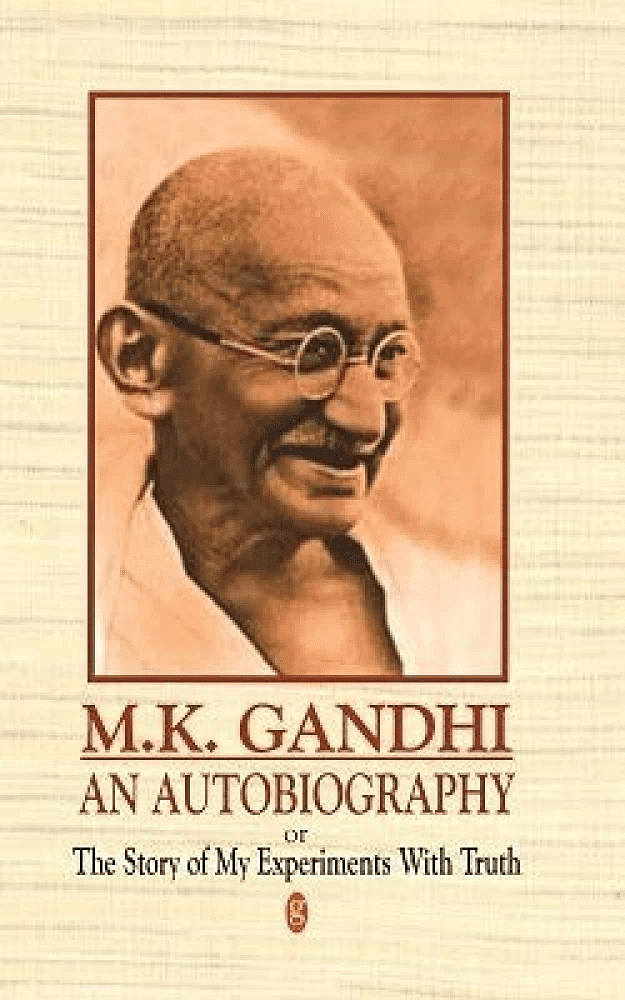
Through Police Eyes
- Government records and police reports offer an official view of Gandhi's activities and their impact.
- These records reveal the British authorities' concerns about the nationalist movement.
Newspapers
- Newspapers from the period covered Gandhi's movements and public reactions.
- They provide contemporary accounts of his campaigns and their reception by different sections of society.
Timeline
- 1915: Gandhi returns to India from South Africa.
- 1917: Champaran Satyagraha.
- 1918: Ahmedabad Mill Strike and Kheda Satyagraha.
- 1919: Rowlatt Act protests and Jallianwala Bagh massacre.
- 1920-1922: Non-cooperation Movement.
- 1930: Salt Satyagraha.
- 1942: Quit India Movement.
- 1947: Indian independence.
- 1948: Gandhi's assassination.
Conclusion
Mahatma Gandhi's leadership was vital in India's independence movement. His dedication to non-violence, social justice, and communal harmony continues to inspire movements for peace and justice around the world, making him a timeless figure in history.
|
30 videos|274 docs|25 tests
|
FAQs on Mahatma Gandhi & The Nationalist Movement Class 12 History
| 1. Who was Mahatma Gandhi and what role did he play in the Indian Nationalist Movement? |  |
| 2. What was the Non-Cooperation Movement and why was it significant? |  |
| 3. Can you explain the Salt Satyagraha and its impact on the Indian independence movement? |  |
| 4. What were the main events of the Quit India Movement? |  |
| 5. What were the last heroic days of Mahatma Gandhi in the context of the nationalist movement? |  |





















